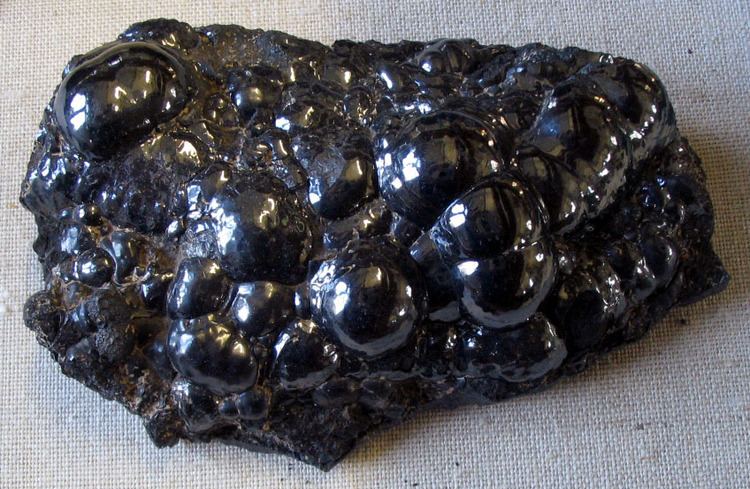Category Oxide minerals Strunz classification 4.DB.05 Space group P42/mnm | Formula(repeating unit) MnO2 Crystal system Tetragonal | |
 | ||
Crystal class Ditetragonal dipyramidal (4/mmm)H-M symbol: (4/m 2/m 2/m) | ||
Pyrolusite is a mineral consisting essentially of manganese dioxide (MnO2) and is important as an ore of manganese. It is a black, amorphous appearing mineral, often with a granular, fibrous or columnar structure, sometimes forming reniform crusts. It has a metallic luster, a black or bluish-black streak, and readily soils the fingers. The specific gravity is about 4.8. Its name is from the Greek for fire and to wash, in reference to its use as a way to remove tints from glass.
Contents
Occurrence
Pyrolusite and romanechite are among the most common manganese minerals. Pyrolusite occurs associated with manganite, hollandite, hausmannite, braunite, chalcophanite, goethite and hematite under oxidizing conditions in hydrothermal deposits. It also occurs in bogs and often results from alteration of manganite.
Use
The metal is obtained by reduction of the oxide with sodium, magnesium, aluminium, or by electrolysis. Pyrolusite is extensively used for the manufacture of spiegeleisen and ferromanganese and of various alloys such as manganese-bronze. As an oxidizing agent it is used in the preparation of chlorine; indeed, chlorine gas itself was first described by Karl Scheele in 1774 from the reaction products of pyrolusite and hydrochloric acid. Natural pyrolusite has been used in batteries, but high-quality batteries require synthetic products. Pyrolusite is also used to prepare disinfectants (permanganates) and for decolorizing glass. When mixed with molten glass it oxidizes the ferrous iron to ferric iron, and so discharges the green and brown tints (making it classically useful to glassmakers as a decolorizer). As a coloring material, it is used in calico printing and dyeing; for imparting violet, amber, and black colors to glass, pottery, and bricks; and in the manufacture of green and violet paints.
Dendritic manganese oxides
Black, manganese oxides with a dendritic crystal habit often found on fracture or rock surfaces are often assumed to be pyrolusite although careful analyses of numerous examples of these dendrites has shown that none of them are in fact pyrolusite. Instead, they are other forms of manganese oxide.
